Have you ever poured your heart into a social media post only to see it get just a few likes from loyal followers? You spend hours crafting creative social media marketing ideas, designing visuals, writing captions, and picking the right time to post, yet your work fades in the endless scroll.
You’re not alone. Social media now has over 70% of businesses competing for attention. By 2025, the number of social media users will reach 5.42 billion. Standing out is harder than ever, even if your content is great.
The issue isn’t your effort on social media. It’s about figuring out how to stand out when everyone uses similar social media marketing ideas. If you feel stuck or overwhelmed while marketing on social media, you still have options.
This post shares 15 creative social media marketing ideas to help you cut through the noise and actually get noticed. These ideas suit any business, big or small.
What is Social Media Marketing?
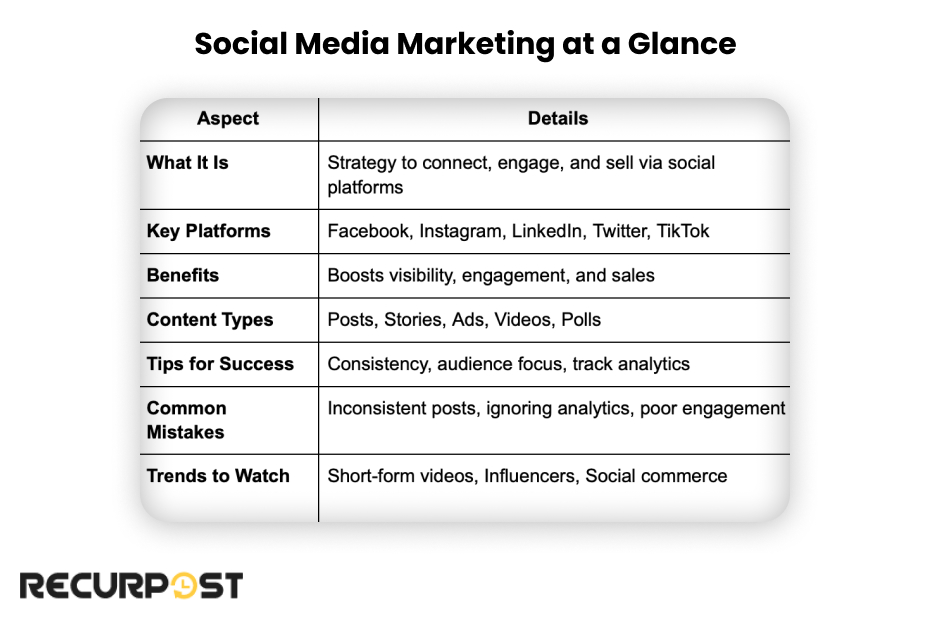
Social media marketing builds relationships and drives real connections through content shared on platforms like Instagram, TikTok, LinkedIn, Facebook, and YouTube.
Social media marketing through visual storytelling, videos, influencer partnerships, and meaningful conversations helps build brand awareness, spark engagement, generate leads, and bring traffic to your website.
The best social media marketing ideas center around content your audience actually cares about, not just chasing likes.
Essential Foundations for Effective Social Media Marketing
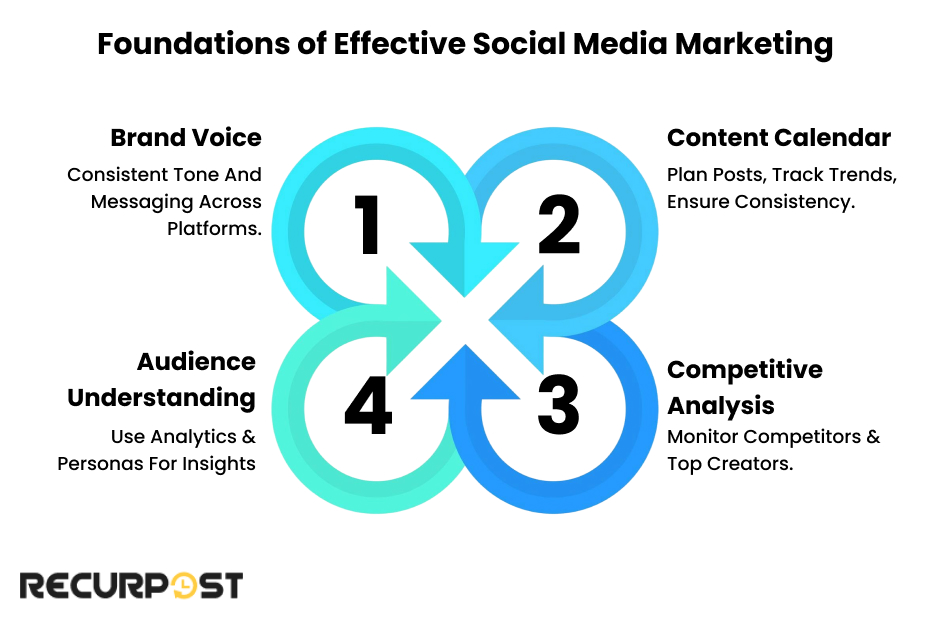
You need a solid foundation before implementing creative marketing ideas:
Developing a Strong Brand Voice
Your brand voice represents your business personality through all content. Without a clear definition, your message can feel bland or forgettable, even with great social media marketing ideas behind it.
A strong brand voice while marketing reflects who you are and what you stand for, whether bold, friendly, or professional. It helps shape every post and turns your social media marketing ideas into content that feels honest and personal to your audience.
Tips for developing a strong brand voice:
- Create a brand style guide outlining your tone, messaging style, preferred social media channels, and visual elements.
- Stay consistent. Whether you’re sharing quick tips on TikTok or writing a long-form post on LinkedIn, your voice should feel cohesive.
- Engage genuinely with comments on your social media post, think of every comment or message as part of your brand voice, not just a reaction to your social media marketing ideas, or a marketing opportunity.
Creating a Content Calendar That Works
A content calendar filled with diverse social media content ideas acts as your roadmap. Without it, your social media posts can feel random and disconnected.
A content calendar helps you:
- Stay consistent, even when you hit a creative block or run out of new social media content ideas.
- It can also help answer the question: How often should post to maintain momentum?
- Plan your social media content around trending topics, seasonal campaigns, and ideas that matter to your audience.
- Keep your sanity by organizing creative social media posts in advance and saving time week to week.
Here’s a simple content calendar template you can try:
| Date | Platform | Content Type | Topic/Theme | Visuals Required |
| 1st Week | Reels | Product Showcase | Product Photos | |
| 2nd Week | Blog Promotion | Industry Insights | Infographic | |
| 3rd Week | Live Session | Q&A with Experts | Live Video | |
| 4th Week | TikTok | Tutorial Video | How-To Guides | Short Video Clips |
Need to know how much it will cost to turn your social media marketing plan into action? Check out this helpful guide: How Much Does Social Media Marketing Cost
Competitive Social Media Analysis That Doesn’t Feel Like Copying
Competitive analysis means reviewing creative social media content examples to spot what works and what doesn’t, then adjusting your own content accordingly.
To conduct a competitive analysis on Social Media:
- Identify your top competitors and track their social media posts, engagement levels, and how audiences respond.
- Notice their tone, creative visuals, hashtag choices, and how they drive interaction.
- Use platforms like BuzzSumo or SEMrush to collect content insights.
Don’t only watch your competitors on social media. Follow social media content creators and influencers in your industry. Borrow what inspires you, but build your own creative social media post. For extra inspiration, search for social media marketing ideas Reddit.
Understanding Your Audience on Social Media: The Real Game-Changer
Knowing your audience helps you create social media content that actually connects.
- Who are they?
- What do they care about?
- Why should they care about what you have to say?
Use social platform analytics like Facebook Insights, Instagram Insights, and LinkedIn Analytics to learn more about:
- Age, gender, and location.
- Interests and content preferences.
- What types of content spark likes, shares, or comments?
Understanding their pain points, interests, and daily habits leads to social media content they actually want to engage with. If you need a starting point, look up social media post ideas for small business.
Why Creativity in Social Media Marketing Is Essential in 2025
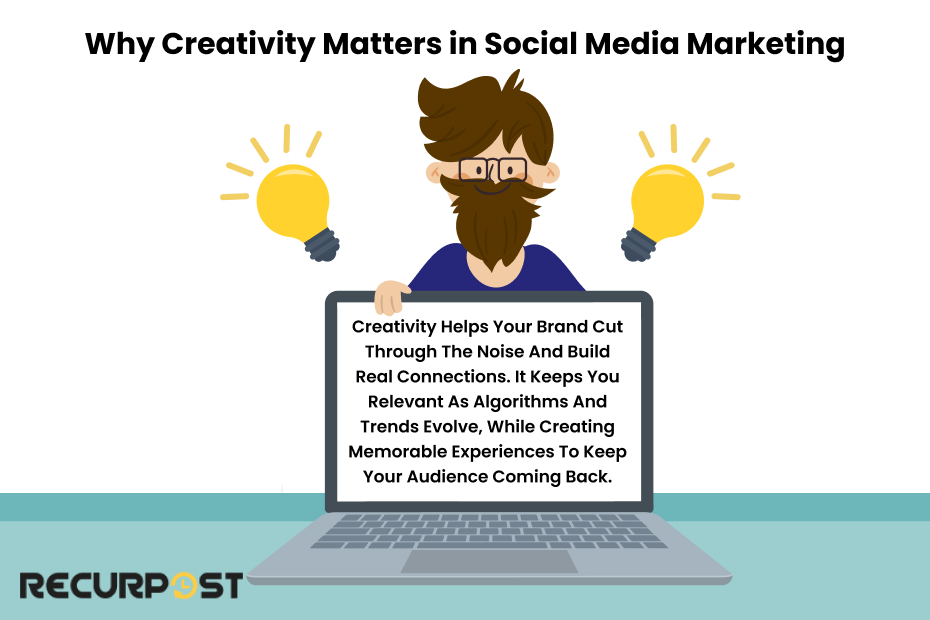
Social media presence requires more than just showing up. Every brand is trying to stand out on social media, which creates nonstop noise across channels.
Here’s why fresh content and Social media marketing ideas matter now more than ever:
1. Market Saturation
Over 70% of businesses use social platforms to promote themselves, filling feeds with endless content. Just being there isn’t enough anymore; originality matters.
Creative posts make users pause mid-scroll, spark curiosity, and help your brand show up in a sea of similar messages.
Small businesses don’t need big marketing budgets to win. Creative content, tested across platforms like TikTok and LinkedIn, helps you grow a social presence that feels authentic and new.
2. Changing Algorithms
Social media algorithms on Instagram, Facebook, and TikTok now favor engaging, authentic content over straight-up promotional posts, rewarding consistency, creativity, and active interaction.
Generic social media content no longer performs well. Audiences want connection beyond marketing messages through crafted experiences, conversations, and recognition.
3. Video Dominance
Videos comprised 82% of all internet traffic in 2022 because videos engage viewers, deliver information efficiently, and offer easy consumption on social media platforms.
Video content on social media must remain relevant, entertaining, and valuable. Reels, TikToks, and YouTube Shorts dominate social media as users increasingly turn to bite-sized, visually stimulating content to hold attention. Consider when you should go live to maximise real-time engagement.
If you’re not tapping into video content, you’re missing out on a huge opportunity to boost brand awareness and nurture a loyal, engaged audience.
4. Automation and Scheduling
Creativity for social media content requires energy. Constantly generating new ideas, visuals, and social media captions by hand can lead to burnout.
Tools like RecurPost streamline content creation, scheduling, and repurposing, helping you maintain a steady social presence without needing constant manual input.
Consistency is key to your social media marketing. Posting valuable, high-quality content regularly forms the backbone of any strong social media strategy. For inspiration, check out 100 social media post ideas.
10 Fresh and Unique Creative Social Media Marketing Ideas
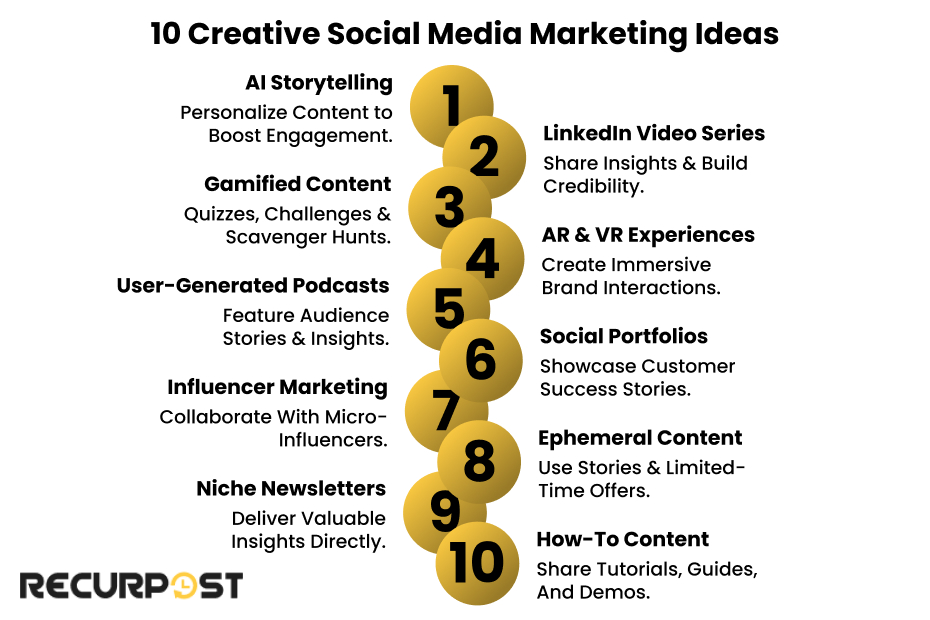
Here are 10 creative social media marketing ideas you can start using today:
1. AI-Generated Personalized Storytelling on Social Media
AI empowers you to deliver tailored social media content that speaks directly to your audience’s interests.
Hyper-personalized storytelling creates a sense of understanding, making your brand feel more relatable to the audience.
Why It Works:
People want relevant content on social media tailored to their needs, not random messaging. Personalized content increases engagement by up to 80%.
How To Do It:
Fitness brands can use AI tools to deliver tailored motivational messages, workout routines, and nutrition tips based on user progress, offering a customized trainer experience on social media.
New businesses can leverage AI tools to create highly targeted campaigns right from the start, increasing effectiveness. Check out the best social media marketing campaigns here.
2. Interactive Video Series on LinkedIn
LinkedIn has transformed into a hub for authentic conversations, educational content, and community engagement.
Producing a monthly video series featuring industry insights, expert interviews, or user-generated content can position your brand as an authority in its niche.
Why It Works:
LinkedIn videos generate 20x more shares than text posts, making them a powerful tool to demonstrate expertise, build credibility, and engage your audience.
How To Do It:
If you’re a B2B consultancy, consider running a “Weekly Insights” video series where you simplify complex topics into actionable, valuable takeaways. Share client success stories, thought leadership content, and practical business advice. Compiling case studies into a series is a great way to showcase your expertise. Learn about social media positioning for content creators.
3. Gamified Social Experiences
Turning your content into a game makes interactions feel fun and engaging, rather than forced or generic. This is a great way to create moments of excitement for your audience.
Why It Works:
Gamification can boost engagement rates on social media by 47%. And when people enjoy interacting with your brand, they’re more likely to share your content with others.
How To Do It:
If you’re a travel agency, create a “Guess the Destination” challenge where users guess locations based on cryptic clues given in your social media posts. Offer rewards such as discounts or free travel guides for those who guess correctly. Consider running giveaways as part of the reward structure.
4. AR and VR Content Takeover
AR and VR content offer your audience the chance to experience your brand in exciting new ways. Both Augmented Reality (AR) and Virtual Reality (VR) are creating buzz across social media platforms.
Why It Works:
Over 77% of Gen Z consumers favor interactive, visually dynamic social media content. AR and VR let users immerse themselves in your brand’s world, creating memorable experiences.
How To Do It:
If you’re a home decor brand, provide an AR tool on your social media posts that allows users to visualize how your furniture would look in their rooms. Let them customize colors, materials, and layouts before buying.
5. User-Generated Podcast Series
Involve your audience directly in your social media podcast to build trust and authority. This is an excellent way to share user generated content (UGC).
Why It Works:
Podcasts are expected to reach over 600 million global listeners by the end of 2025. They provide a unique opportunity to create deep, meaningful connections with your audience.
How To Do It:
If you’re a wellness brand, start a podcast where users share personal mental health journeys, fitness stories, or productivity tips. Let your audience speak for your brand

Scheduling Tip: Use tools like RecurPost to plan and automate the sharing of podcast snippets to keep your audience engaged.
6. Social Media Portfolio Showcase
Showcasing your work on social media provides tangible proof of your capabilities, not just talk. This is where social media portfolios play a key role.
Why It Works:
Story-driven portfolios on social media help build audience trust. By showcasing your best work, you give potential clients a glimpse into your expertise and values.
How To Do It:
If you’re a design agency, create visually engaging posts that showcase your clients’ success stories and completed projects. Encourage your audience to share their experiences with your brand using branded hashtags.
Even better, turn your social media portfolio into a conversation. Share a recent project post and ask your audience for their thoughts.
7. Influencer Marketing for Niche Audiences
Influencer marketing isn’t just about partnering with celebrities or big names. Micro-influencers often have a more significant impact when they align with your brand’s values.
Why It Works:
Influencers help you connect with new audiences while boosting your brand credibility. They’ve built trust with their followers, so when they recommend your product, it feels more like genuine advice than an advertisement on social media.
How To Do It:
If you’re a beauty brand, partner with skincare influencers to create tutorial videos or product reviews. Let them demonstrate how your product solves real issues.
Remember, influencer marketing isn’t just about tapping into someone else’s audience. It’s about fostering relationships on social media that feel authentic and mutually beneficial.
8. Ephemeral Content Series
The fear of missing out drives engagement with ephemeral social media content. Creating content that disappears within 24 hours triggers urgency and builds curiosity. Think Instagram Stories, Snapchat Snaps, and Twitter Fleets. These content moments are perfect for time-sensitive announcements.
Why It Works:
Instagram Stories occupies 26% of the average user’s time, which is more than traditional posts. Exclusivity and time-sensitivity make people more likely to engage with your content.
How To Do It:
If you’re an e-commerce brand, run “24-Hour Flash Sales” through Instagram Stories or Snapchat. Create anticipation by sharing countdowns and sneak peeks of upcoming deals.
This strategy works particularly well during holidays, product launches, and special promotions. The key is to make it feel like an exclusive opportunity your social media audience won’t want to miss.
To effectively plan and execute these campaigns, read: Social Media Marketing Business Plan.
9. Niche Social Media Newsletters
Creating genuinely interesting newsletters can differentiate your brand from competitors. Creating niche-specific newsletters on platforms like LinkedIn or Instagram is a fantastic way to build a loyal community.
Why It Works:
Social newsletters have 5x higher engagement than regular posts. They’re personal, targeted, and offer genuine value.
How To Do It:
If you’re a marketing agency, publish a “Monthly Creative Insights” newsletter sharing industry trends, helpful resources, and real-time conversations with industry leaders. For more ideas, search for social media marketing post ideas.
The trick is to make your social media newsletter feel like a gift, not a chore. People should feel excited to open your messages, not burdened.
10. Creating Interactive “How-To” Content
Interactive educational content that people can watch, engage with, and share beats static blog posts any day.
Why It Works:
“How-to” content is one of the most searched categories across social media platforms. People appreciate practical advice in their social media feed, especially when it’s broken down into simple, digestible steps.
How To Do It:
If you’re a DIY brand, create Instagram Reels or TikToks that showcase unique projects your audience can recreate using your products.
Host live Q&A sessions, webinars, or tutorials. Invite your audience to ask questions, share feedback, and make it feel like an authentic conversation, not a one-way lesson.
Remember, how-to content shines when it feels accessible. Simplify complex ideas, use visuals, and communicate like a person, not like a brand trying too hard.
Creative Social Media Advertising Ideas
While organic content builds relationships, paid social media advertising amplifies your reach and targets specific audiences with precision. Here are some creative social media marketing ideas for advertising that go beyond traditional promotional posts:
Retargeting with Storytelling
Create ad sequences that tell a story across multiple touchpoints. If someone visits your website but doesn’t convert, show them a series of ads that continue the story and address potential objections. The first ad could introduce a problem, the second show your solution, and the third highlight customer success stories.
Interactive Ad Formats
Use polls, quizzes, and carousel ads that encourage user participation. Interactive ads generate more engagement than static ones and make your brand unforgettable. Facebook and Instagram polls, for example, allow followers to vote on product features or upcoming content, creating deeper engagement with your brand.
Video Testimonial Campaigns
Turn customer success stories into short video ads. Real people sharing authentic experiences lead to higher click-through rates than typical promotional content. Keep these videos under 30 seconds for maximum impact, especially on platforms like TikTok and Instagram.
Localized Ad Targeting
Create hyper-local campaigns that speak to specific geographic markets with relevant references and offers. Ads that tap into local events, weather conditions, or cultural references have higher click-through rates than generic messaging. This is one of the most effective social media marketing ideas for targeted engagement.
Limited-Time Ad Offers
Create urgency with countdown timers and exclusive time-limited promotions on your social media. These ads leverage scarcity, increasing conversion rates compared to standard promotional content. Time-sensitive offers are powerful social media marketing ideas that drive action and enhance engagement.
5 Future-Facing Creative Social Media Marketing Ideas
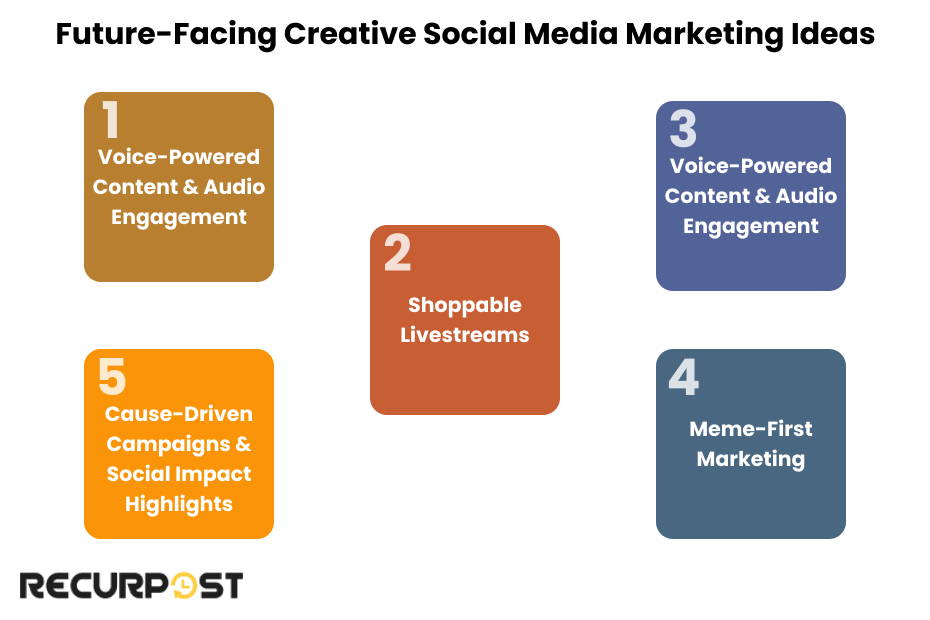
The social media landscape is evolving rapidly, and staying ahead means embracing new formats and strategies that capture attention. Here are five future-facing social media marketing ideas that are expected to gain massive traction in the coming years.
11. Voice-powered content & Audio Engagement
While video continues to dominate, voice-powered content is emerging as a powerful tool for brands to connect with audiences in more personal and accessible ways. Think audio tweets, voice notes, podcasts, and even Clubhouse-style platforms.
Why It Works:
People are drawn to content they can consume while multitasking. Plus, there’s something deeply personal about hearing someone’s voice, because it feels real, genuine, and unscripted on every social media platform.
How To Do It:
If you’re a coaching or wellness brand, consider hosting audio Q&A sessions or releasing weekly motivational voice notes. Another great approach is launching a podcast where you interview industry experts and answer questions from your audience.
For example, BBC News also publishes podcasts that feature interviews with well known public figures.
You can also experiment with voice-powered SEO to ensure your brand is discoverable through voice search tools like Siri, Alexa, and Google Assistant.
12. Shoppable Livestreams
Ever heard of “See Now, Buy Now” social media marketing? It’s an approach where viewers can purchase directly from live video content. This social commerce trend is rapidly gaining traction on platforms like Instagram, Facebook, and TikTok, making it one of the most innovative social media marketing ideas.
Why It Works:
People love real-time interactions. They get to see the product in action, ask questions, and purchase on the spot, making it the most effective advertisement on social media. It feels more like a personal recommendation than a traditional advertisement or marketing.
How To Do It:
If you’re an e-commerce brand, host live product showcases where viewers can instantly purchase featured items. Offer exclusive discounts during the livestream to create urgency and drive conversions.
This strategy works particularly well for beauty brands, fashion retailers, and tech companies launching new products. It’s about making the shopping experience on social media feel engaging, exclusive, and seamless.
13. Meme-First Marketing
Memes are the internet’s love language. They’re funny, relatable, and, when done right, highly shareable. The magic of memes isn’t just in their humor; it’s in their cultural relevance, making them one of the most creative social media marketing ideas today.
Why It Works:
Meme-based marketing generates 60% more engagement than traditional posts. By creating memes that are timely and relevant, you make your brand part of ongoing conversations, encouraging shares, engagement, and user interaction.
How To Do It:
If you’re a tech company, create memes that simplify complex topics in an entertaining way. For inspiration, check out creative social media post examples from industry leaders who successfully incorporate memes.
If you’re a fashion brand, capitalize on trending memes to present your latest collections in a fun, light-hearted manner that resonates with your audience.

Tip: Make sure your memes feel genuine. Forced humor can backfire. Keep an eye on trending topics and adapt your content quickly before the moment passes.
You might also be interested in: How to Start a Social Media Marketing Company
14. Educational Mini-Series
People appreciate gaining knowledge even if it is from social media content, but they want it in bite-sized, easily digestible pieces. This is where educational mini-series come in, making them one of the most effective social media marketing ideas. Think short videos, carousel posts, or even Twitter threads delivering value-packed lessons.
Why It Works:
Educational content helps build authority and boosts audience trust. People are more likely to follow and engage with brands that provide solutions to problems and teach them new skills. This is why educational mini-series are becoming key social media marketing ideas.
How To Do It:
If you’re a marketing agency, create a weekly series called “Marketing Mondays” where you share quick tips, case studies, and actionable insights. If you’re in the wellness space, try a “Wellness Wednesday” series with practical health and fitness advice.
To take it a step further, turn your series into a LinkedIn newsletter. Social newsletters often have 5x higher engagement than regular posts, making them an ideal addition to your social media marketing ideas.
15. Cause-Driven Campaigns & Social Impact Highlights
Today’s consumers are more socially conscious than ever before, making them want to support brands that stand for more than just profits on social media. Highlighting your brand’s values, social initiatives, and sustainability efforts can create meaningful connections.
Why It Works:
People are more likely to support brands on social media that align with their personal values. Cause-driven marketing isn’t just great for your audience; it’s beneficial for your business too.
How To Do It:
If you’re a clothing brand, showcase your commitment to ethical production and eco-friendly materials. If you’re a tech company, highlight your initiatives in digital education and accessibility, making these efforts a core part of your social media marketing ideas for clothing brands.
For example, CocaCola’s Arctic Home campaign focused on protecting the Arctic polar bear, their brand mascot. The Iconic Coca-Cola Red Cans Turn Arctic White with polar bear art. The effort raised 4 million dollars for Arctic conservation. Sales rose compared to the previous holiday push. Brand love increased by 10 percent.
Don’t just talk about what you’re doing, show it. Share authentic stories, customer testimonials, and behind the scenes content to make your campaigns feel genuine and impactful. These authentic touches strengthen your social media marketing.
Creative Social Media Promotion Strategies
Promotional content doesn’t have to feel pushy or sales-heavy. Here are creative approaches to promote your products or services while maintaining audience engagement:
Flash Sale Storytelling
Instead of just announcing discounts, create mini-stories around your promotions. Share why you’re offering the deal, what it means to your business, or how it helps customers achieve their goals. Narrative-based promotions generate higher conversion rates than standard discount announcements.
User Challenge Promotions
Launch challenges where participants showcase your product in creative ways. Offer prizes or discounts to winners while generating authentic user-generated promotional content. User-generated content drives higher conversion rates than brand-created promotional materials.
For example, in 2020, Nike launched the #livingroomcup challenge to get people moving at home. It all started when Cristiano Ronaldo posted a video doing 142 reps of a core crusher in just 45 seconds. He wore Nike gear and dared his followers to beat his score. From there, the challenge took off, with users around the world sharing their own workout clips and trying to top Ronaldo’s record.
Behind-the-Scenes Promotions
Show the making of your products, introduce team members, or share your business journey. People buy from brands on social media they feel connected to, making transparency a powerful promotional tool. Behind-the-scenes content increases brand trust and purchase intent.
For example, Gucci’s “Making of” stories give a behind-the-scenes look at how their products come to life, often highlighting the inspiration and craftsmanship behind each piece.
Value-First Promotions
Create educational or entertaining content that delivers value first, with a subtle promotional element at the end. For example, a cooking brand might share a recipe video that uses their products without making the product the focus. This approach generates higher engagement than direct promotional content.
Cause-Related Promotions
Connect your promotional activities to social or environmental causes that align with your brand values. For example, “For every purchase this week, we’ll plant a tree.” Cause-related promotions increase purchase intent among socially conscious consumers while building positive brand associations.
For example, back in 2006, TOMS launched its One for One campaign: for every pair of shoes sold, they donated another to someone in need. Since then, they’ve given away over 105 million pairs. Beyond shoes, TOMS also puts part of its profits toward children’s education, healthcare, and overall well-being, through cash grants, product donations, and strong partnerships with trusted organizations.
How to Create Engaging Content That Resonates
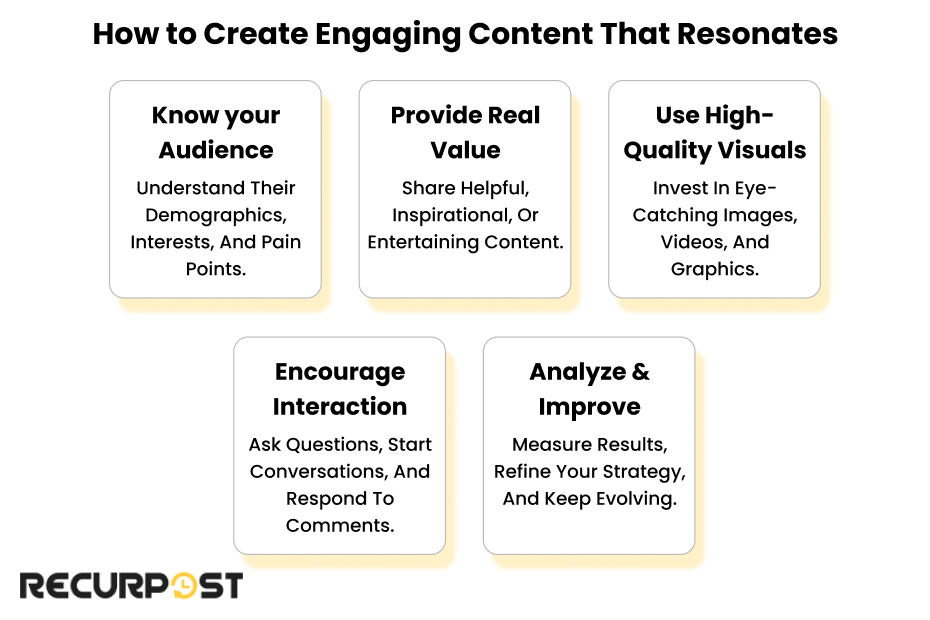
Here’s how to make your content connect effectively with your audience:
1. Research Industry Insights of Social Media
Stay current with industry trends to remain relevant and competitive.
- Follow industry leaders and top creators on platforms like Facebook, Instagram, and Pinterest.
- Pay attention to trending hashtags, topics, and ongoing conversations to ensure your content taps into current conversations and remains visible.
- Use tools like BuzzSumo and Google Trends to track what’s gaining traction across social media platforms,
2. Focus on Quality Content
Focus on quality content rather than random posting, as audiences can detect inauthentic efforts.
- Invest in high-quality visuals, videos, and graphics that engage your audience and align with your social media marketing goals.
- Craft captions that feel conversational and human.
- Make sure your content reflects your brand identity and personal values.
3. Measure Meaningful Social Media Metrics
Measure the right metrics to evaluate your content’s effectiveness and adjust your social media marketing tactics accordingly.
- Engagement rate (likes, comments, shares)
- Audience growth (followers, subscribers)
- Website traffic (clicks, conversions)
- Top-performing content (what’s resonating most)
Analyze conversations in comments, DMs, and emails for valuable insights beyond numerical metrics. These insights are crucial for refining your social media marketing strategy.
How to Craft a Long-Term Content Strategy
Transform great social media marketing ideas into a sustainable, long-term marketing strategy. If you need a comprehensive plan, search for a social media marketing strategy pdf.
1. Content Planning
Create a robust content calendar that outlines your posts for the month, quarter, or even the year. Include everything from educational content to entertaining content, storytelling, promotions, and audience interaction.
2. Diversify Your Content Types
Use visuals, videos, memes, blog posts, stories, and live sessions to keep your audience engaged. The more diverse your content types, the better your chances of reaching a variety of audiences and optimizing your social media marketing efforts.
3. Adjust Based on Analytics
Pay attention to your social media metrics. What’s working? What’s not? Use that information to refine your social media marketing strategy and improve your content.
Future Trends to Watch in Social Media Marketing (2025 & Beyond)
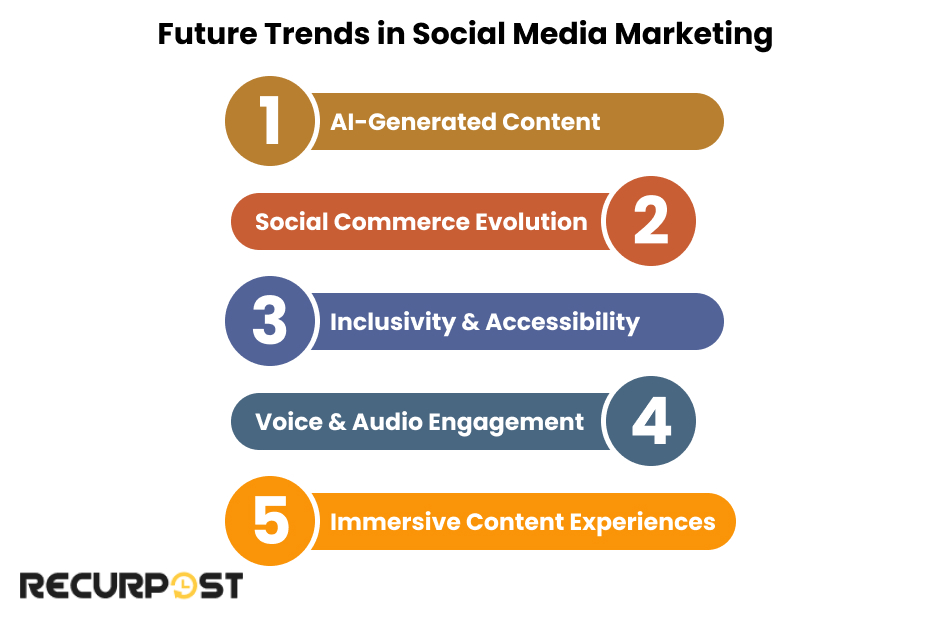
Here are the future trends reshaping social media marketing:
1. AI-Generated Content: Automation Tools to Streamline Creativity and Boost Engagement
Automation is essential for smooth content creation on social media. With the increasing demand for personalized, high-quality content on social media, AI tools are making the creative process faster and more effective. Brands are using AI tools to:
- Generate captions and visuals that resonate with their target audience, helping brands create content that truly connects.
- Analyze performance metrics and suggest improvements to help improve overall social media marketing efforts.
- Personalize content based on user preferences and browsing behavior, ensuring that content is more tailored to audience needs.
Why This Matters:
Reach your audience with custom content that stands out among the massive amount of content they encounter daily. AI-generated content helps you scale creativity while maintaining quality.
2. Enhanced Social Commerce: Seamless In-App Purchasing Experiences
E-commerce is no longer confined to traditional websites, because Social platforms are integrating in-app purchasing features to streamline the buying experience. Think shoppable Instagram posts, Facebook Marketplace, and TikTok Shopping.
Why This Matters:
Consumers expect to purchase products instantly without leaving their favorite social media platforms. Brands that tap into social commerce can see a significant boost in conversions and customer engagement.
How to Implement:
- Create seamless, shoppable content that integrates naturally with the platform, not as a hard sell.
- Host interactive live streams on social media platforms where users can purchase items while watching in real-time.
- Use targeted social media campaigns to direct potential buyers to your integrated store, making the buying process as smooth as possible.
3. Inclusivity & Accessibility: Reaching Diverse and Underrepresented Audiences
Consumers expect brands to reflect their values, identities, and experiences through inclusive content on social media that resonates with diverse audiences.
Why This Matters:
Brands that overlook social media representation risk alienating large segments of their audience and missing opportunities to connect with underrepresented communities.
How to Implement:
- Create content that speaks to diverse audiences, including those from underrepresented communities, ensuring your brand feels accessible to all.
- Add alt text and captions to your social media posts’ visuals to ensure they’re accessible to everyone, including individuals with disabilities.
- Partner with influencers from various backgrounds to authentically promote inclusivity and broaden your reach.
Tips & Best Practices for Implementing Creative Strategies
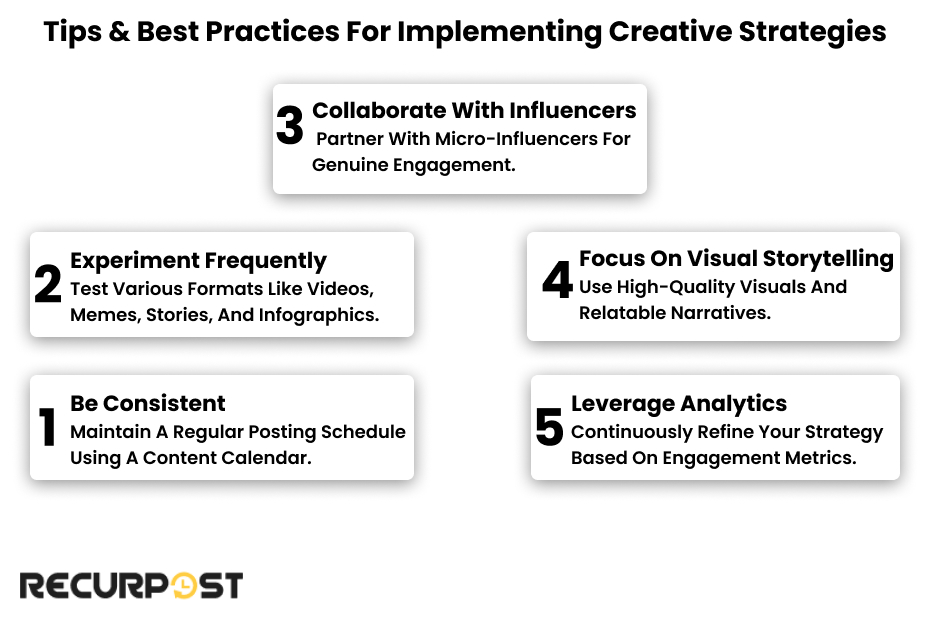
Here’s how to turn creative ideas into effective social media marketing campaigns:
1. Consistency: Develop a Content Calendar to Ensure Regular Posting
Maintain consistent posting to stay relevant with your audience. That’s why having a content calendar is essential for a successful social media marketing strategy, helping you to:
- Plan content ahead of time to maintain a steady flow of posts.
- Keep a regular posting schedule to keep your brand top of mind.
- Align your social media marketing efforts with your business objectives to ensure cohesion and effectiveness.
2. Experimentation: Test Various Formats and Analyze Results
Diversify your content to cater to your audience’s diverse interests.
- Experiment with videos, memes, infographics, live streams, and even Instagram Stories and Reels to identify what resonates best with your audience.
- Analyze which formats are getting the highest engagement and refine your content based on those results.
- Adjust your content strategy based on meaningful metrics, focusing on engagement rather than vanity metrics like likes.
3. Influencer Collaborations: Partner with Micro-Influencers for Authentic Promotion
Micro-influencers often generate higher engagement rates than celebrity endorsements, offering a more authentic connection with your target audience.
- Collaborate with influencers who genuinely share your brand’s personal values, making your promotion feel more authentic and aligned with your brand identity.
- Build strong relationships with influencers who can genuinely connect with your audience and foster trust.
- Encourage user-generated content to increase engagement and amplify your reach through authentic recommendations.
4. Visual Storytelling: Invest in High-Quality Visuals and Storytelling
Visual content serves as a powerful storytelling tool as:
- It captures attention and holds your audience’s interest.
- It builds emotional connections and deepens audience loyalty.
- It increases brand awareness and creates a memorable presence.
Invest in professional photography, video production, and design. Don’t forget the power of storytelling on social media. Share your journey, struggles, and wins. Make your audience feel connected to your brand’s story.
5. Leverage Analytics: Refine Strategies Based on Engagement Metrics
Measure performance metrics to refine your marketing strategy rather than guessing. Use analytics tools to:
- Track engagement rates, audience growth, and conversion rates to measure the effectiveness of your social media marketing strategy.
- Identify top-performing content to understand what resonates most with your audience.
- Continuously optimize your social media marketing efforts based on these insights.
Platforms like Google Analytics and RecurPost provide valuable insights to improve your social presence and refine your approach.
6. Leveraging Modern Tools
To stay ahead, you need to use the right social media tools. Beyond social media schedulers like RecurPost and Hootsuite, and analytics platforms like Google Analytics, you can use:
- Canva for creating visually engaging content and infographics.
- ChatGPT for generating creative content ideas and drafting captions.
- Google Trends and Analytics to understand search behavior and monitor website traffic from your social content.
Social Media Content Suggestions Framework
Building a Content Suggestions System
Rather than constantly brainstorming from scratch, establish a repeatable framework for generating content ideas:
The Content Pillar Method:
Establish 3-5 core topics your brand consistently covers. For each pillar, keep a running list of subtopics, audience questions, and various content formats you can use to address them. This structured method ensures social media content consistency while offering variety.
Audience Question Mining:
Regularly collect questions from customer service interactions, social media comments, and industry forums. These real questions become your most valuable content ideas because they address actual audience needs. Social media content addressing common questions sees 48% higher engagement rates.
Content Repurposing Matrix:
Create a system where one piece of content transforms into multiple posts across various formats—such as a blog post becoming an infographic, video tutorial, and a series of social media tips. This method saves time by 60% while maintaining a steady content schedule.
Seasonal Content Calendar:
Map your content ideas to annual events, holidays, and industry seasons. This proactive planning allows you to create timely content in advance, rather than scrambling to create seasonal posts last-minute. Seasonal content receives 37% higher engagement when published 1-2 weeks before peak interest.
Competitor Gap Analysis:
Regularly analyze competitor content to identify gaps they’re missing that align with your expertise. These gaps represent opportunities to provide unique value to your audience. Content addressing unmet needs generates 53% more shares than conventional industry topics.
Conclusion
Brands posting generic content will be overshadowed by those offering distinctive content in the intensifying social media competition.
Creativity on Social media is about being real, relatable, and relevant rather than flashy. It’s about taking the time to understand your audience, experimenting with new formats, and refining your strategy based on what works.
The creative social media marketing ideas outlined above are more than just tactics. They represent opportunities to build something meaningful, something that connects with your audience on a deeper level. Whether you’re a small business trying to grow or a larger brand aiming to stay relevant, embracing creativity as part of your social media marketing ideas is your key to success.
Ready to take your social media game to the next level? It’s time to put these social media marketing ideas into action and start building a captivating presence that resonates with your audience and drives meaningful engagement.
FAQs on Social Media Marketing Ideas
1. What Is Creative Social Media Marketing and How Can It Boost Your Social Media Presence?
Creative social media marketing involves using innovative content strategies to engage your target audience across multiple social platforms. Effective social media marketing uses storytelling, interactive content, and creative visuals to capture attention, increase brand visibility, and enhance your online presence.
2. How Do You Build a Solid Social Media Marketing Strategy for Different Social Media Platforms?
A successful social media marketing strategy starts by defining clear business goals, understanding your audience, and selecting the most suitable platforms. The key is to create a content calendar, conduct a competitive analysis, and align your marketing plan with your audience’s interests for optimal engagement.
3. What Role Does User-Generated Content Play in Social Media Marketing Campaigns?
User-generated content (UGC) is a powerful tool for building credibility and engagement. Share user generated content like customer success stories, social media posts, and reviews on your social accounts to boost brand interaction and create moments of connection with new followers.
4. How Can You Ensure Effective Social Media Marketing with Quality Content?
To ensure effective social media marketing, create high-quality, visually engaging content that speaks to your audience. A clear strategy with consistent posting, storytelling, and interactive content, along with measuring metrics, will help your efforts stand out and keep your audience engaged.
5. How Can Influencer Marketing Enhance Your Social Media Campaigns?
Influencer marketing can broaden your reach by partnering with individuals who share your brand’s values and align with your target audience. This approach boosts engagement and visibility, resulting in increased brand awareness and follower growth through authentic promotions.
6. What Are the Key Performance Indicators (KPIs) for Measuring Your Social Marketing Strategy?
Effective social media management requires tracking KPIs such as engagement rate, audience growth, website traffic, and top-performing content. Meaningful metrics help refine your social strategy and boost your brand identity across multiple platforms.
7. How Can Competitive Analysis Improve Your Social Media Marketing Plan?
By regularly analyzing your competitors’ social media content, advertising, and overall engagement, you can identify gaps in their strategies. These insights allow you to improve your content and social media marketing tactics, setting you apart from others in the industry.
8. How Can a Consistent Brand Voice Improve Your Social Media Presence?
Maintaining a consistent brand voice across platforms strengthens your identity and builds trust with your audience. By aligning your content with your values and ensuring consistent messaging, your social media marketing presence becomes more relatable and reliable.
9. What are some of the best new social media platforms for marketing?
Alongside traditional platforms like Facebook and Instagram, newer channels such as X and Threads are gaining popularity for real-time interaction and community building. These platforms are great for sharing dynamic content and fostering deeper connections with your audience.

Ayushi Jain is a content writer with expertise in creating engaging, SEO-friendly content across various industries. With a focus on storytelling and clarity, she helps brands connect with their audience effectively.





